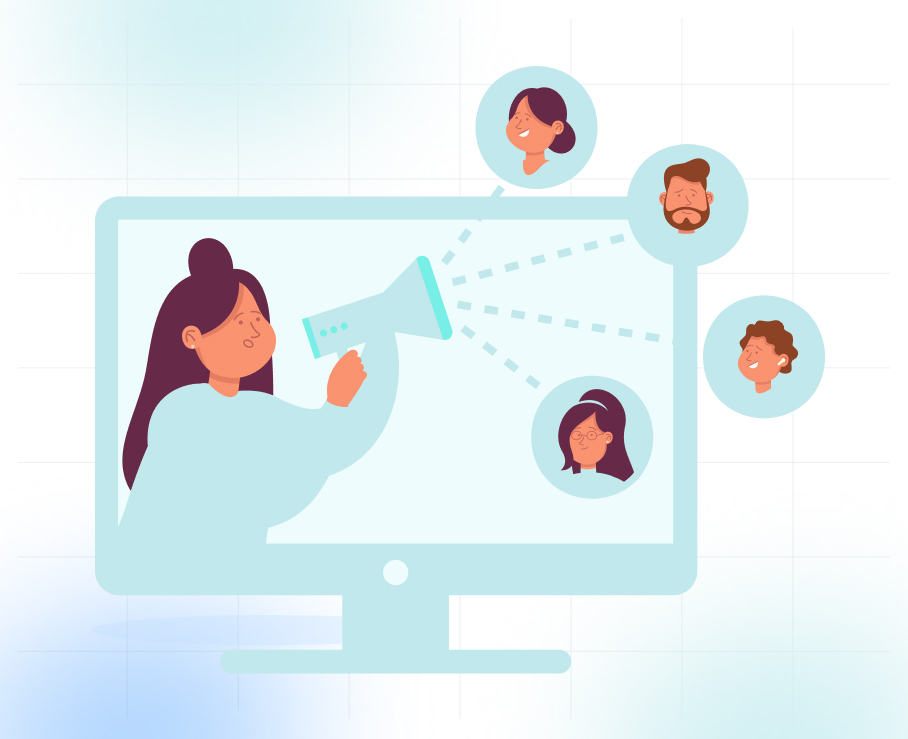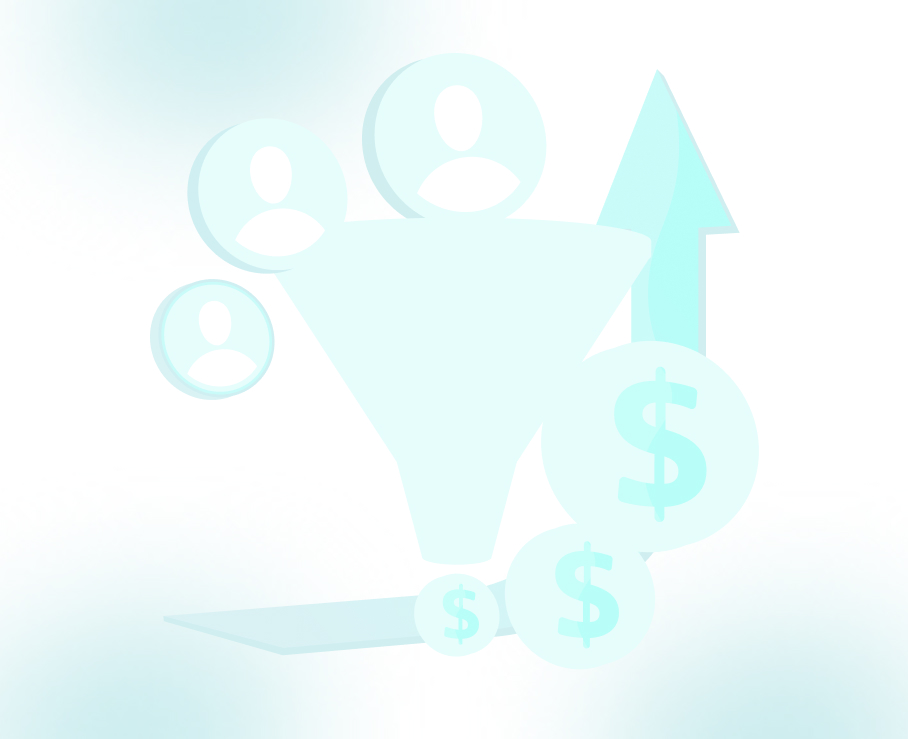
Top Appointment Setting Strategies for Lead Generation
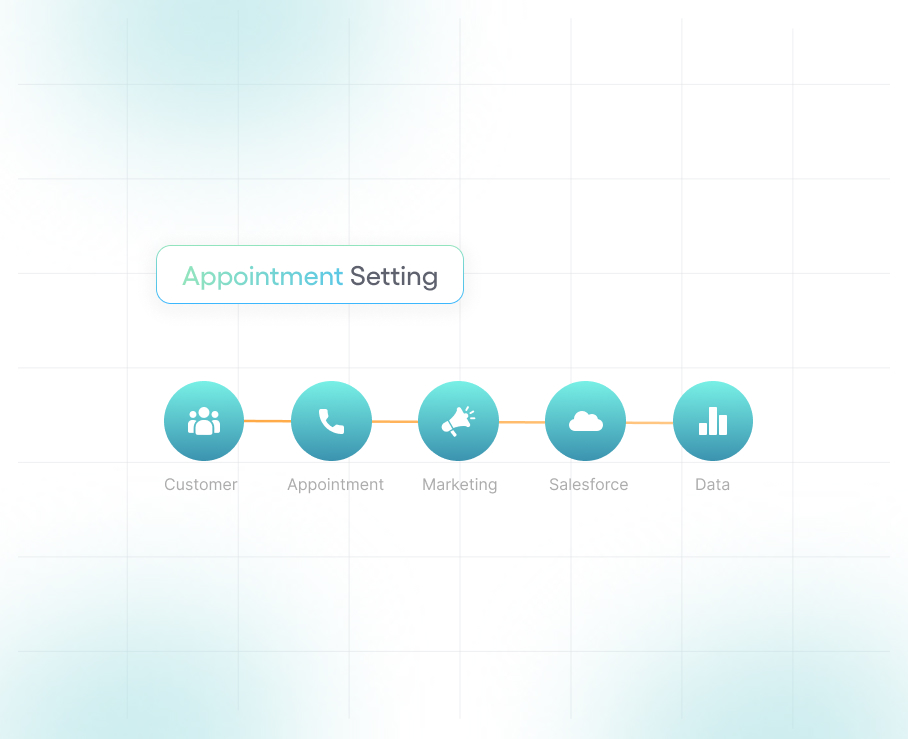
Lead generation is essential for B2B growth, but collecting leads is just the beginning. The real challenge lies in turning those contacts into qualified appointments that lead to actual revenue.
Many businesses struggle with this. Even when they have a strong pipeline, poor appointment-setting processes often lead to missed opportunities, wasted time, and low conversion rates.
Without a clear system to qualify leads, follow up strategically, and book meetings with decision-makers, your sales team risks spending effort on prospects who are unlikely to close.
In this guide, we’ll break down actionable strategies to transform your lead generation through appointment setting, helping you build a cleaner pipeline, increase meeting success rates, and drive sales conversations that actually convert.
Quick Summary Before You Dive In
- Appointment setting is more than filling your calendar; it's about getting real sales conversations with the right people at the right time.
- Multi-touch outreach (especially email + follow-ups) works way better than cold calls or one-touch outreach.
- If your team isn't setting SMART goals or qualifying leads properly, you're wasting time talking to the wrong prospects.
- Personalizing your message and using proof (like testimonials or results) makes a big difference in getting replies.
What is Appointment Setting?
Appointment setting is the process of engaging qualified leads and booking meetings between sales teams and decision-makers. In B2B lead generation, it serves as the critical bridge between capturing interest and closing deals.
Unlike generic outreach, appointment setting focuses on identifying sales-qualified leads (SQLs), prospects who match your Ideal Customer Profile (ICP) and show intent to engage. The goal? To schedule high-value conversations that move prospects further down the sales funnel.
Appointment setting typically involves:
- Lead Qualification: Ensuring the prospect fits your ICP based on factors like industry, role, and budget.
- Personalized Outreach: Crafting messages that address specific pain points and offer relevant solutions.
- Consistent Follow-Up: Staying top-of-mind through strategic touchpoints until the meeting is confirmed.
Why Appointment Setting Drives Effective Lead Generation and Sales Success?
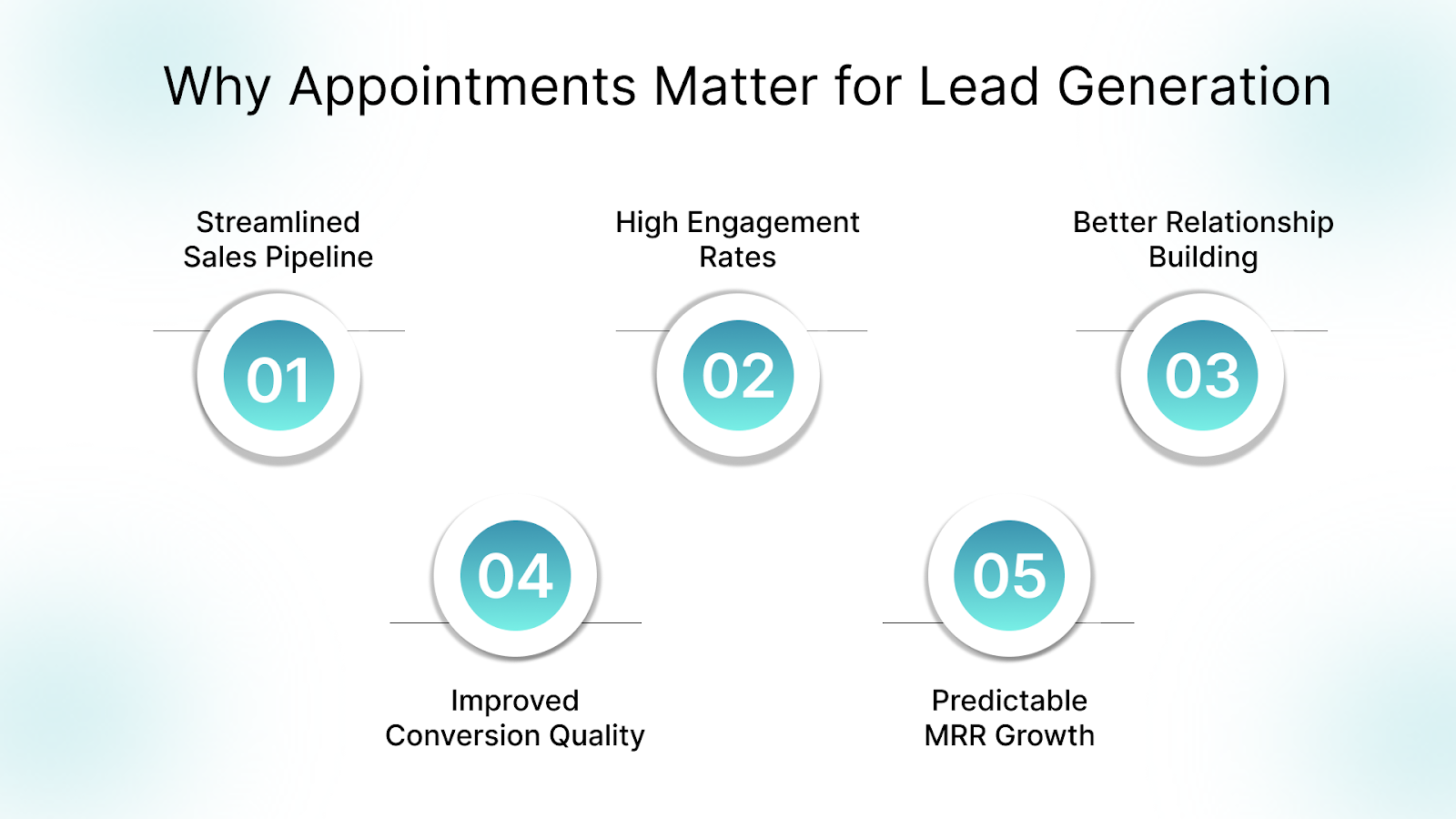
Effective appointment setting goes beyond booking time slots, it’s a strategic layer in your B2B lead generation engine. Instead of chasing cold contacts or mass-blasting leads, this approach prioritizes sales-qualified leads (SQLs) and aligns your outreach with real buyer intent.
Here’s how a strong appointment-setting strategy powers better pipeline results:
- Streamlined Sales Pipeline: By qualifying leads early, your sales team can focus on high-intent decision-makers, improving efficiency, saving time, and boosting close rates.
- Higher Engagement Rates: Strategic, multi-channel appointment setting (email, phone, and more) increases the likelihood of response and drives deeper engagement.
- Better Relationship Building: Every qualified meeting is a chance to build rapport, even if the lead doesn’t convert now, it strengthens your long-term pipeline.
- Improved Conversion Quality: Personalized, value-driven conversations help uncover pain points, position your offering, and shorten sales cycles.
- More Predictable MRR Growth: Fewer no-shows, better-qualified meetings, and consistent follow-ups lead to more deals and more Monthly Recurring Revenue (MRR).
Also read: How to Succeed as an Appointment Setter?
Now, let's explore some proven strategies for effectively implementing appointment setting and driving even greater success in your sales process.
Key Appointment Setting Strategies for Lead Generation
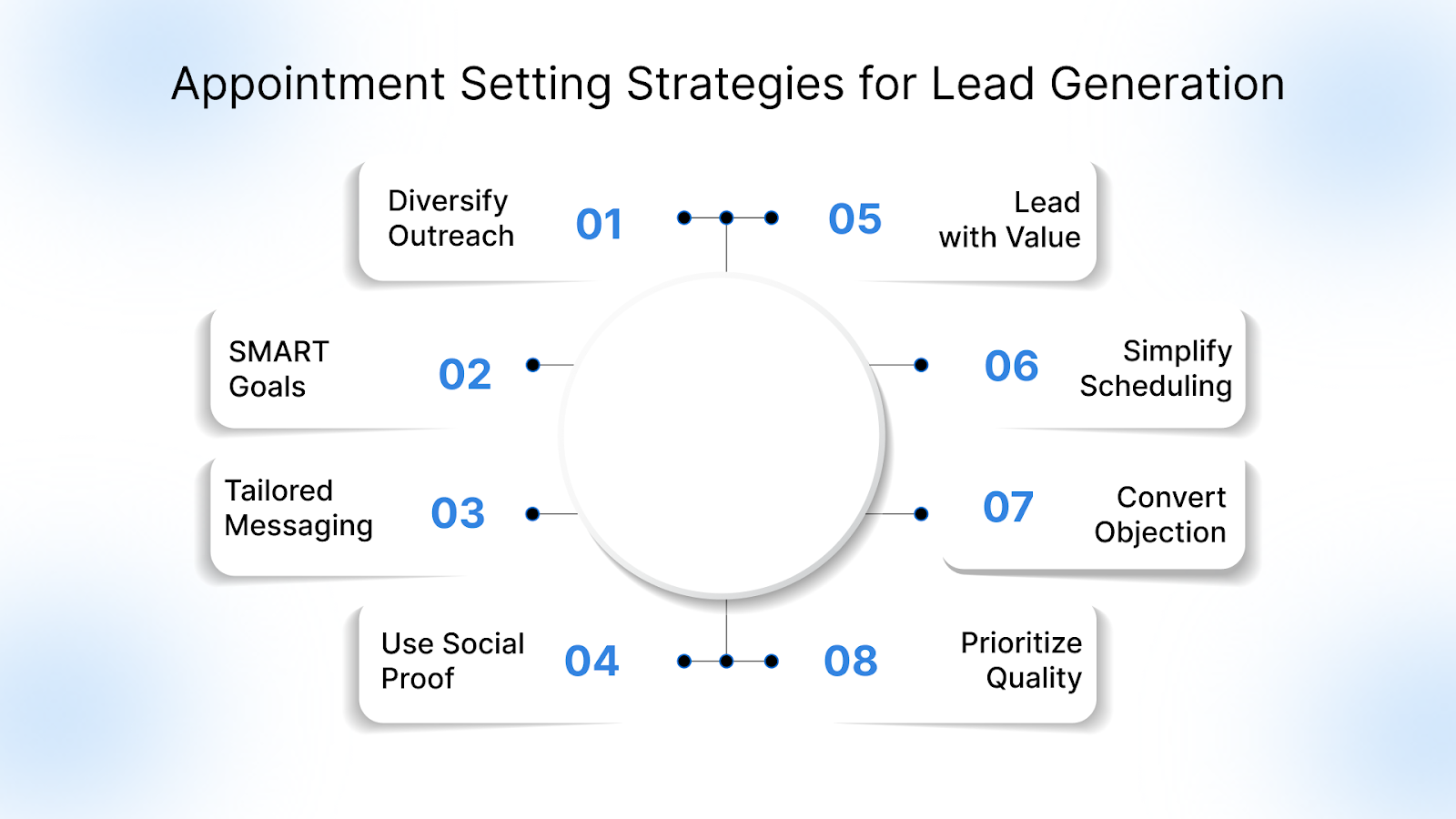
Appointment setting is more than just filling up a calendar; it’s about engaging the right prospects at the right time to drive meaningful sales conversations.
The following strategies will help you optimize your appointment-setting process and convert more leads into valuable, long-term customers.
1. Utilize Multi-Channel Outreach
In B2B lead generation, relying on a single touchpoint no longer works. Today’s decision-makers expect contextual, personalized communication, delivered through multiple channels. That’s why high-performing teams blend email outreach with targeted follow-ups via phone or scheduling tools to keep engagement high.
At TLM (The Lead Market), we focus on email-first strategies powered by our proprietary tools, enabling precision outreach, better personalization, and real-time campaign performance without relying on traditional CRMs.
Studies show multi-channel B2B outreach can improve engagement rates by over 250%, particularly when paired with smart segmentation and follow-ups.
Actionable Tips:
- Start with Email: Craft a short, personalized email that speaks to the prospect’s core pain point and outlines a quick solution.
- Follow Up by Phone: If there’s no response, follow up with a brief, value-driven call that reinforces your message.
- Use Scheduling Tools: Always include a link (e.g., Calendly) to make booking a meeting frictionless.
- Stay Compliant: Ensure all emails follow CAN-SPAM regulations for ethical outreach.
Also read: Importance of Email Marketing in Your Lead Generation Strategy
2. Set SMART Goals
SMART goals — Specific, Measurable, Achievable, Relevant, and Time-bound, are essential for keeping your appointment-setting efforts focused and outcome-driven.
In B2B sales, where long cycles and complex decision-making are the norm, SMART goals ensure your team prioritizes quality outreach that moves the needle on Monthly Recurring Revenue (MRR).
Research indicates that setting specific and challenging goals can lead to up to 90% better performance compared to vague or easy goals.
Actionable Tips:

- Break Down KPIs: Instead of “book more calls,” define specific KPIs like “book 15 SQL appointments this month from the MSP segment.”
- Use Real-Time Dashboards: TLM’s proprietary tools replace the need for CRMs, offering live campaign metrics to help adjust strategy quickly.
- Review Outreach Effectiveness: Regularly analyze which industries (e.g., MSPs or warehousing) respond best to your campaigns and double down where results are strongest.
- Keep Timelines Tight: Set internal deadlines like “convert responses into meetings within 72 hours” to maintain lead momentum.
3. Personalize Your Messaging
Personalization involves tailoring your outreach messages to address the specific needs and pain points of each prospect.
Personalized email content can boost average cold email response rates by up to 32.7% compared to generic messages.
Actionable Tips:
- Use Industry-Specific Insights: Tailor messages for MSPs, staffing firms, or manufacturing companies by referencing common pain points like downtime, hiring delays, or operational inefficiencies.
- Refer to Real Outcomes: Showcase how similar businesses benefitted (e.g., “One mid-sized MSP reduced their lead response time by 40% using our appointment-setting model”).
- Map Value to Their Role: Frame messaging based on whether you're reaching a CEO, Sales Manager, or BDM, each will respond to different value points.
- Keep Messaging CAN-SPAM Compliant: Ensure all communications follow compliance protocols, a standard followed across all TLM campaigns.
- Leverage Smart Scripts: TLM’s customizable email templates help craft hyper-targeted, personalized messaging without sacrificing efficiency.
Want to see how our Email Marketing and Account-Based Marketing approaches support precision messaging at scale? Let’s talk.
4. Leverage Social Proof and Testimonials
Trust is everything in B2B sales, and nothing builds it faster than real-world success stories. Using testimonials, case studies, and 3rd-party validation like G2 reviews can dramatically increase your chances of converting leads into booked appointments.
On average, testimonials on sales pages can boost conversions by 34%.
Actionable Tips:
- Add Testimonials to Emails: Include a brief, impactful testimonial from a client in the same industry.
- Share Case Studies: Link to a relevant case study that highlights the success your service brought to a similar business.
- Use Success Metrics: Highlight measurable outcomes from your clients.
5. Lead with Value, Not Features
Decision-makers don’t want a list of features, they want to know what your solution can do for them. Value-driven conversations center the prospect’s needs, aligning your messaging with tangible outcomes like increased efficiency, reduced costs, or faster conversions.
Organizations that embrace value-based selling strategies see sales performance improve by 20% over those relying on traditional approaches.
At TLM, our appointment scheduling strategies are built around value-first messaging designed to engage qualified leads and shorten your sales cycle.
6. Make Scheduling Frictionless with the Right Tools
Even the best outreach can fall flat if your scheduling process is clunky. Simplifying how prospects book meetings reduces drop-offs and keeps momentum strong, especially in B2B sales, where timing is everything.
One B2B SaaS company found that over 55% of booked demos came directly through their scheduling tool, showing just how much prospects value convenience.
Actionable Tips:
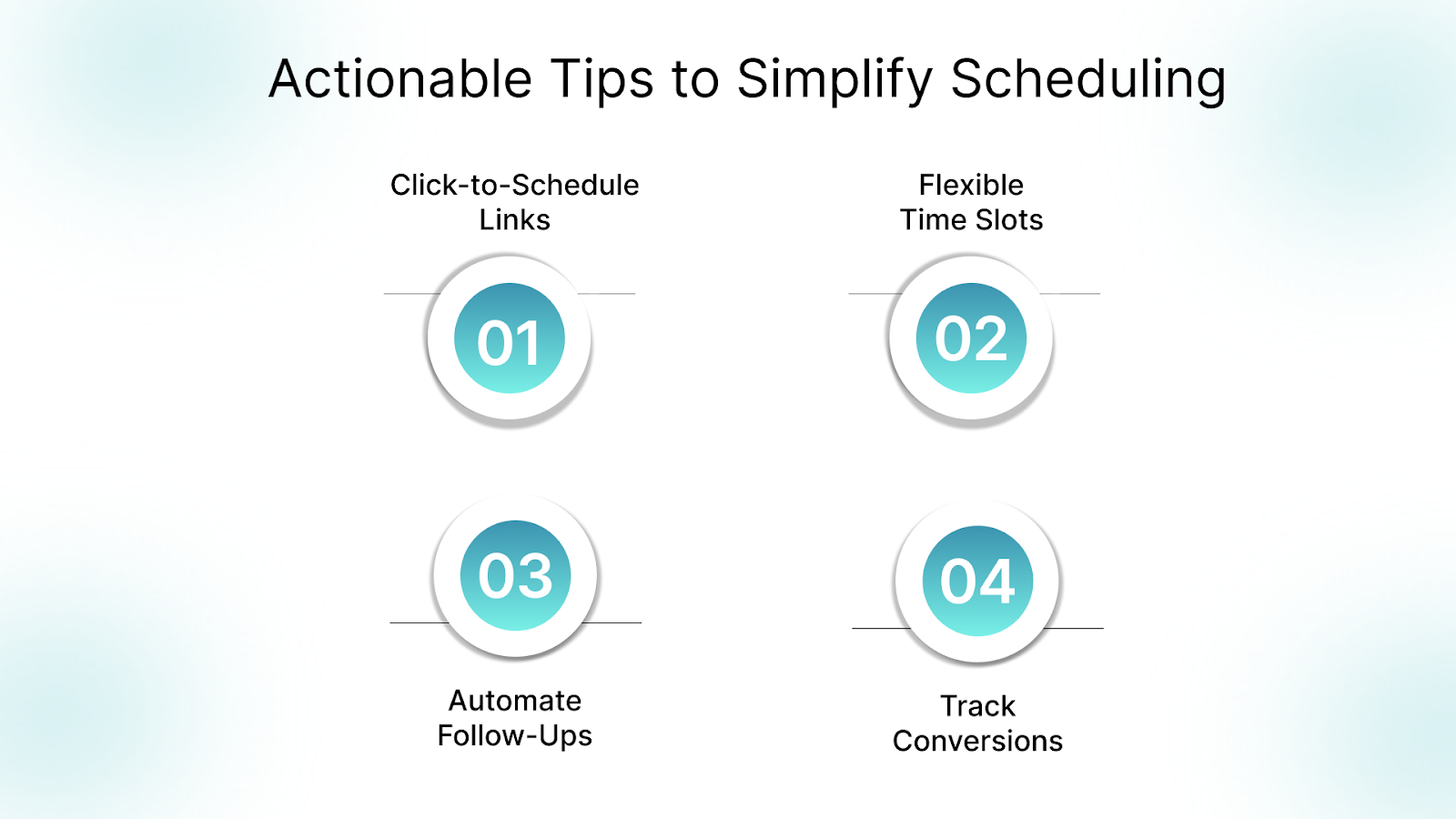
- Use Click-to-Schedule Links: Embed tools like Calendly in your outreach so prospects can pick a time without the back-and-forth.
- Offer Flexible Time Slots: Account for different time zones, especially when targeting international leads in the U.S., Canada, and Australia.
- Automate Follow-Ups: Set up confirmation emails and reminders to reduce no-shows.
- Track Conversions: Monitor booked meetings by source to see which channels are driving the most appointments.
7. Turn Objections into Opportunities
Objections aren’t roadblocks, they’re openings for deeper conversations. When handled effectively, objections can actually increase close rates by up to 64%, according to sales enablement benchmarks.
In B2B lead generation and appointment setting, addressing concerns like “not the right time” or “we already have a provider” with empathy and clarity can transform hesitation into trust and ultimately, into a scheduled meeting.
Actionable Tips:
- Anticipate Common Pushbacks: Budget, timing, or vendor fatigue know what typically stalls your leads and prepare responses.
- Ask Clarifying Questions: Uncover the true reason behind the objection. “Can you share what makes now feel like the wrong time?”
- Use Case-Driven Reassurance: Share a relevant success story or testimonial that mirrors their concern and shows how it was resolved.
8. Prioritize Quality Over Quantity
In a B2B appointment setting, more leads don’t always mean better results. Chasing volume often leads to wasted resources on unqualified contacts, which drains your sales team and delays conversions.
That’s why focusing on sales-qualified leads (SQLs), those who are vetted, relevant, and ready for sales conversations is key to sustainable MRR growth.
Actionable Tips:
- Define Your ICP: Outline your Ideal Customer Profile by vertical (e.g., MSPs, staffing firms, SaaS, manufacturers), company size, and decision-maker roles.
- Use Lead Scoring Models: Assign scores based on fit and engagement level to rank leads objectively.
- Audit Your Funnel: Identify where weak leads are slipping through, whether it’s targeting, messaging, or qualification
How TLM Inside Sales Can Help with Appointment Setting
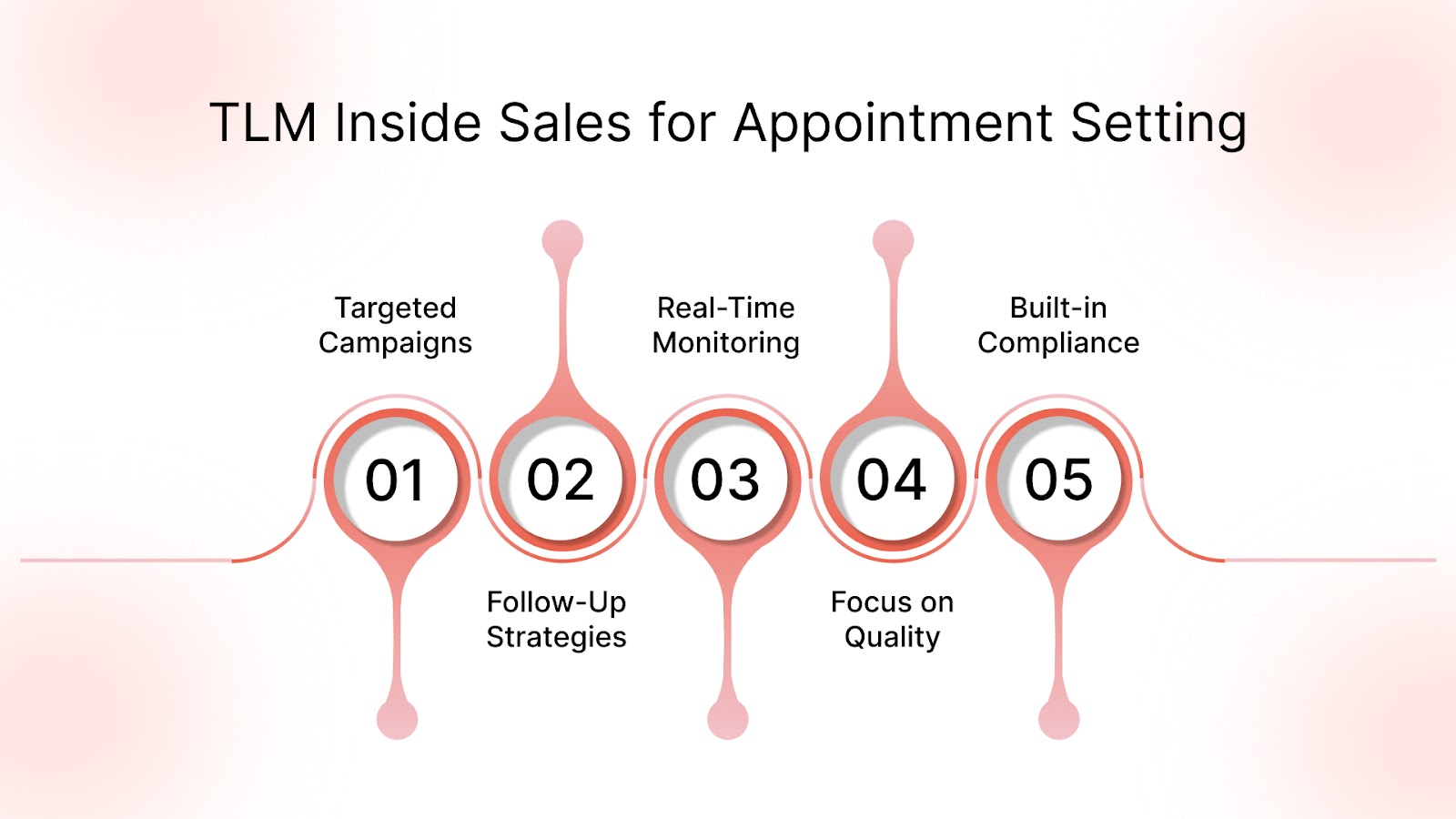
At TLM (The Lead Market), we don’t just fill calendars, we help you build a predictable pipeline of sales-qualified leads. Our appointment-setting services are designed to eliminate the guesswork and manual effort from your outreach, so your team can focus on what matters: closing.
With over 9 years of experience in B2B sales enablement, we specialize in engaging decision-makers across the U.S., Canada, and Australia, especially in industries like MSPs, SaaS, staffing, and manufacturing.
- Targeted Campaigns: Every campaign is tailored to your Ideal Customer Profile (ICP), ensuring outreach only hits prospects who match your goals, pain points, and purchase readiness.
- Effective Follow-Up Strategies: Our proven follow-up techniques ensure prospects stay engaged throughout the process, increasing the chances of securing confirmed appointments.
- Real-Time Campaign Monitoring: Get complete visibility into performance through our live dashboard, allowing you to track booked meetings, response rates, and more.
- Focus on Quality Not Volume: Every meeting we schedule is with a sales-qualified lead, so your team speaks only with prospects ready to buy, not just browse.
- Built-in Compliance & Deliverability: Every message is CAN-SPAM compliant and optimized for inbox delivery, so your outreach is professional, effective, and risk-free.
Conclusion
If you want to grow your sales pipeline and close more deals, appointment setting isn’t just a task, it’s a strategy. From multi-touch outreach to value-driven conversations and leveraging the right tools, each step brings you closer to engaging qualified, sales-ready prospects.
But the key is consistency, and that’s where a trusted partner can make all the difference.
At TLM, we help B2B companies like yours move beyond cold lists and no-show meetings. Our appointment scheduling services are built to deliver real, measurable results, with a focus on sales-qualified leads, personalized outreach, and long-term MRR growth.
FAQs
1. How can I effectively segment my leads to enhance appointment setting?
Segmenting leads based on criteria such as industry, company size, role, and engagement level allows for more personalized outreach. This targeted approach increases the likelihood of securing appointments with decision-makers who are most likely to convert.
2. What role does timing play in the appointment setting?
Timing is crucial; reaching out during optimal hours can significantly impact response rates. Studies suggest that contacting leads within the first five minutes of their inquiry can increase conversion rates by up to nine times.
3. How can I handle objections during the appointment setting process?
Anticipate common objections and prepare thoughtful responses. For instance, if a prospect mentions they're too busy, acknowledge their time constraints and propose a brief, value-focused meeting. This demonstrates respect for their time while emphasizing the potential benefits of the discussion.
4. What are some common mistakes to avoid in the appointment setting?
Avoid generic messaging and a lack of follow-up. Personalized communication that addresses the prospect's specific needs is more effective. Additionally, consistent and timely follow-ups are essential to keep the conversation moving forward.
5. Which pricing model is best—pay-per-appointment or monthly retainer?
Pay-per-appointment is ideal if you want guaranteed outcomes and clear ROI; you only pay when a meeting is booked. Monthly retainers work well for long-term, consistent outreach and scalability. Choose based on your growth stage, goals, and how hands-on you want to be.


